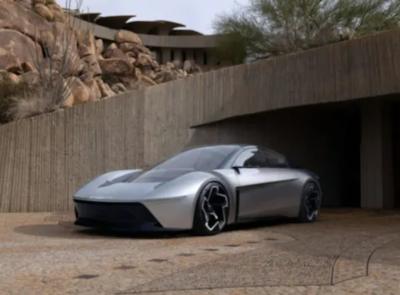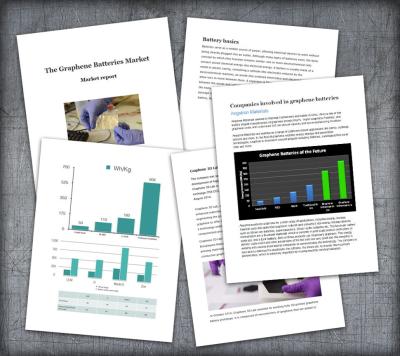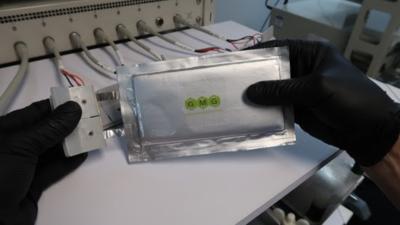Researchers develop approach for creating tight arrangement of bilayer alkali metals between graphene layers for improved batteries
Researchers at AIST, Osaka University, Tokyo Polytechnic University, Kyushu University, and National Tsing Hua University, have developed a technique to insert alkali metals (AMs) into the interlayers of graphene. They them used low-voltage scanning transmission electron microscopy (LV-STEM) to visualize the atomic structure of the intercalated AMs (potassium, rubidium, and cesium) in the bilayer graphene (BLG). The team's findings revealed that the intercalated AMs adopt bilayer structures with hcp stacking, and specifically a C6M2C6 composition.
The performance of rechargeable batteries is a key factor influencing the driving distance of electric vehicles and the usage time of smartphones. Improving the performance of these electronic devices is possible if rechargeable batteries can accumulate greater electrical capacities. Graphite, the electrode material used in batteries, is composed of multilayers of graphene, with alkali metals placed between the layers to facilitate the flow of electrons during charging and discharging. Achieving a high density of alkali metals storage between graphene layers could increase the electric capacity.
Lyten announces manufacturing milestone - producing Lithium-sulfur batteries at greater than 90% yield
Lyten recently announced it is consistently surpassing 90 percent yield from its automated battery production line, confirming the manufacturability of its lithium-sulfur battery utilizing a sulfur cathode and lithium metal anode.
The lithium-sulfur manufacturing performance has been achieved utilizing standard lithium-ion manufacturing equipment and processes. The conversion of lithium-ion equipment to produce lithium-sulfur batteries in Lyten’s pilot facility required 6 weeks and less than 2% of the total capital cost. This confirms Lyten’s ability to rapidly scale by converting existing Li-ion gigafactories to lithium-sulfur with minimal cost and time.
Graphene Manufacturing Group announces organizational restructuring to cut operating costs
Graphene Manufacturing Group (GMG) has announced it will be implementing a strategic organizational restructuring to reduce operating costs, while maintaining focus on key business objectives including graphene production, energy-saving product revenue, next-generation battery development, and supply chain enhancement.
The organizational overhaul is expected to cut operating costs by A$4.5 million (almost USD$3 million) per annum, according to a statement by the company.
Solidion Technology begins trading on NASDAQ, aims to advance eVTOL aircraft with graphene-enhanced batteries
Solidion Technology, an advanced battery technology solutions developer, began trading on NASDAQ (ticker symbol “STI”) on February 5, 2024. Solidion is the merged entity between Honeycomb Battery Company (HBC, Dayton, Ohio) and Nubia Brand International Co., a special purpose acquisition company (SPAC), based in Dallas, Texas.
Some see electric vertical takeoff and landing (eVTOL) aircraft as the next urban transportation technology breakthrough. At the heart of an eVTOL aircraft is a heavy battery pack. The amount of energy that can be stored in a battery pack with a reduced mass must be significantly increased before the eVTOL industry can literally take off. It is estimated that eVTOL aircraft needs a battery system with a gravimetric energy density > 400 Wh/kg. For an air taxi to carry more passengers, a battery cell energy density higher than 450 or even 500 Wh/kg will be required.
Lyten's graphene-enhanced lithium-sulfur batteries selected as the power source for Chrysler's new Halcyon Concept electric vehicle
Chrysler recently announced its Halcyon Concept electric vehicle, that plans to incorporate Lyten’s lithium-sulfur EV batteries as part of its goal to achieve a lighter weight and longer-range vehicle powered by batteries that utilize no nickel or cobalt.
Chrysler's Halcyon Concept EV. image credit: BusinessWire
Chrysler’s announcement states the Halcyon "envisions incorporating breakthrough Lyten 800V lithium-sulfur EV batteries that do not use nickel, cobalt or manganese, resulting in an estimated 60% lower carbon footprint than today's best-in-class batteries and a pathway to achieve the lowest emissions EV battery on the global market."
Log9 and Trinity Cleantech join forces to develop interoperable charging network
Log9 Materials, an innovator in EV charging technologies which has been working on graphene-based battery solutions, and Trinity Cleantech, a comprehensive provider of sustainable solutions, have reportedly announced a strategic partnership aimed at advancing India's electric vehicle (EV) industry. The companies will work to establish an interoperable charging network.
Trinity Cleantech plans to deploy 2,000 public charging stations under its brand “Thunder+” across India by the end of the next financial year. It plans to lead the market in Type 6 fast chargers, which represent the next-generation standard for charging speed and convenience. Trinity’s Thunder Platform is designed to seamlessly integrate with Log9’s “Instacharge” platform, streamlining operations and enhancing user experience. They have committed to adhering to the BCA LEV DC standard (IS 17017-25 & IS 17017-2-6), which provides users with the confidence to charge anywhere securely. As the EV landscape continues to evolve, Log9 and Trinity are dedicated to adapting to technological advancements in connectors, protocols, and payment gateways, ensuring continued compatibility for years to come.
Graphene-Info updates its Graphene Batteries Market Report
Today we published a new edition of our Graphene Batteries Market Report, with all the latest information. The batteries market is extremely active, as demand from EVs and mobile applications increases R&D efforts, and graphene is seen as a potential material to increase capacity, decrease charging times and improve other performance metrics. This is a major release that contains the latest company updates, projects, research publications and more.
Reading this report, you'll learn all about:
- The advantages of using graphene in batteries
- The different ways graphene can be used in batteries
- Various types of graphene materials
- What's on the market today
The report package also provides:
- A list of all graphene companies involved with batteries
- Detailed specifications of graphene-enhanced anode materials
- Personal contact details into most graphene developers
- Free updates for a year
This Graphene Batteries market report provides a great introduction to graphene materials used in the batteries market, and covers everything you need to know about graphene in this niche. This is a great guide for anyone involved with the battery market, nanomaterials, electric vehicles and mobile devices.
Honeycomb Battery Company and Nubia Brand International announce closing of business combination
Last year, Global Graphene Group (G3) announced plans for its subsidiary, Honeycomb Battery, to merge with a SPAC company (Nubia Brand International Corp.) in a deal worth $925 million. Earlier this month, it was announced that this business combination was completed.
Upon the completion of the business combination, the combined company was renamed Solidion Technology. Beginning on Monday, February 5, 2024, Solidion’s common stock was expected to begin trading on the NASDAQ Global Market under the new ticker symbol “STI.”
GMG updates on progress of its graphene-aluminum batteries
Graphene Manufacturing Group (GMG) has provided a progress update on its Graphene Aluminum-Ion Battery technology being developed by GMG and the University of Queensland (UQ).
The Company has announced it has produced multiple battery pouch cells with over 1000 mAh (1 Ah) capacity. In a recent build to confirm repeatability, the Company's development team has built and confirmed multiple cells, all reportedly testing greater than 1Ah (1000mAh). This is defined by GMG as "a major milestone achieved to demonstrate scalability from coin cells to pouch cells".
Lyten secures $4 Million grant from Department of Energy
Lyten has announced it has secured a $4 million grant from the U.S. Department of Energy (DoE) to accelerate the manufacturing of its advanced lithium-sulfur battery technology. This grant (awarded by the DoE’s Energy Efficiency and Renewable Energy / Vehicle Technologies Office) specifically targets lithium-sulfur technologies that can alleviate offshore supply chain risk for EV batteries and increase EV driving range.
Lithium-sulfur is a chemistry known for decades to potentially hold 2 to 3 times the energy density of lithium-ion but was not envisioned to come into the market until the 2030s due to material science challenges. Lyten set out to accelerate this timeline by using its 3D Graphene material to develop a sulfur-graphene composite cathode. In June 2023, Lyten opened a semi-automated lithium-sulfur pilot line producing pouch and cylindrical cells on its 145,000-square-foot campus in Silicon Valley and will begin to deliver non-EV cells commercially in 2024.
Pagination
- Previous page
- Page 2
- Next page




